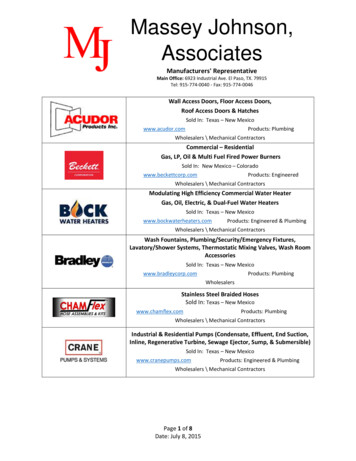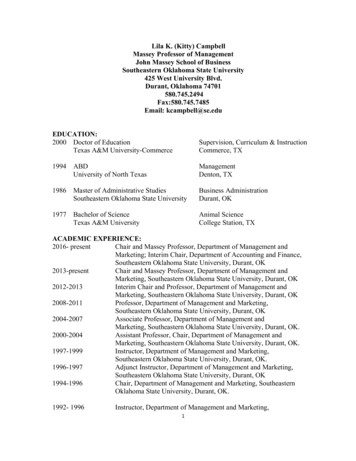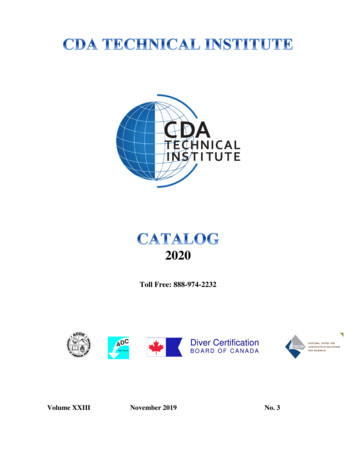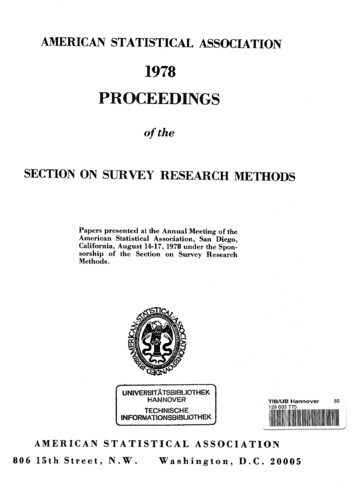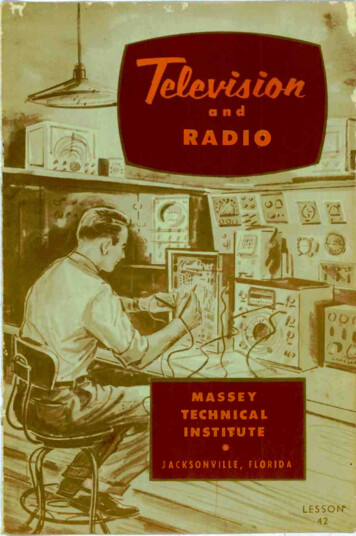
Transcription
KSONVILLE, FLORIDALESSON'42
MOST THINGS WE WORRY ABOUTNEVER HAPPEN.
TRAININGSERVICESEMI -CONDUCTORSAND TRANSISTORSCONTENTS: Introduction-Background of Semi-Conductors-CrystalDetectors-Putting Crystals to Work in Ra d a r-Semi-ConductorsShells in Atomic Structures-Atomic Structures-Early History of Cry-stal Detectors-From Crystal Detector to Transistor-How AtomicStructure Affects Conductive Action-Semi-Conductor Valence BondStructures-Semi-Conductor Electrical Properties-Acceptor Atoms inSemi-Conductors-Positive and Negative Crystals-Rectification-HowCrystals Work in Practice-Items of Special Interest.1.INTRODUCTIONThe vacuum tube has long servedthe electronic industry. In fact, itis the very heart of electronics,and when we think of electronicswe automatically think of vacuumtubes.It is natural that this should beso, since each is such an intimatepart of the other.During recent years, however,we have been hearing with increasing frequency about a newelectronic component which is taking over some of the functions for-merly performed solely by vacuum tubes. We refer to transistors.Due to the fact transistors appear to have certain points of superiority over vacuum tubes for a 185E BY MASSEY TECHNICAL INSTITUTE INC.variety of purposes, some personshave leaped to the conclusion theyare likely to supplant, and replace,vacuum tubes. This is by no meanscorrect.Transistors should be lookedupon as supplementing vacuumtubes. Doing some things betterthan vacuum tubes, and even doing a few things which vacuumtubes cannot do.On the other hand, there aremany fields in which a vacuumtube is vastly superior to transistors, and there are many thingsvacuum tubes do with ease whichare beyond the range of transistors.Working together they supplement each other nicely. In a fewcases, although not many, bothHA -1
substance which possesses theproperty of permitting electricalcurrent to flow rather freely inone direction, but which blocks itsflow in the opposite direction.This,as we have explainedinearlier lessons, is essentially whatwe call rectification.The manner in which such arectifier is placed in a radio cir-cuit to perform the duties of adetector are indicated in Figure3. It serves to rectify the highFIG. 1.-Transistor Radio.transistors and vacuum tubes areused in the same electronic device.There are a few cases where it isdesirable to utilize the uniquequalities of each. The most outstanding example of this is insome of the newer model radiosfor use in automobiles.2.BACKGROUND OF SEMICONDUCTORSSemi -conductors are interwoveninto the pattern of radio since thevery earliest days. Back in thedays when many of us were stillexperimenting with what we thencalled "wireless," one of the mostimportant components in receiving equipment was a little devicewhich we called a "cat whisker,"or "crystal detector."In our lesson on DETECTORSwe touched briefly on the partwhich crystal detectors played inthe early days of radio. It mayseem a little strange for us to return to that subject at this time,but there is a good reason for do-frequency R -F carrier signal sothe audio component can be extracted.It is interesting to note that acrystal detector-unlike a vacuumtube-is not a perfect rectifier.The forward resistance is muchlower than that of the reverse direction, yet the back resistancedoes not completely cut off current during the reverse half -cycles.A vacuum tube is a perfect rectifier, and thus a perfect detector.This means that it does not per-mit any "back current" to flowduring the interval in which thevoltage and current are trying tomove in the backward, or reverse,direction.Since a crystal is unable to completely cut off the flow of currentin the reverse direction, it cannotbe considered a perfect detector,but it is fully capable of reducingthe back current to such a lowlevel that it makes a satisfactorydetector. For the most part, theminute amount of back current isnot a matter of importance, andcan be ignored.However, there are a few situations where even a small amountA crystal detector is a simple of back current cannot be tolerdevice. It consists merely of a tiny ated. In such case, a crystal depiece of semi -conductive crystal tector could not be used.ing so.HA -2
FIG. 2.-Crystal Detector.To obtain a better idea for com-fell into disuse, however, whengraphs in Figure 4. The top graphin Figure 4 shows the wave -formthe most part were able to do thembetter.This is the way the graph wouldappear on the screen of an oscilloscope if the modulating signalrecurred at regular intervals.The center graph shows whathappens when the signal is applied through a crystal detector,The early model vacuum tubedetector served the dual purposeof demodulating the R -F carriersignal while providing some degree of amplification to the audiosignal. This matter of amplifica-parison of the forward and re- vacuum tubes were invented. Vacverse currents in crystal types of uum tubes could do more thingsrectifiers, we present the series of than the simple crystal, and forshapes of a modulated R -F carrier.and is rectified. Most of the lowerhalf of the modulated envelope iscut-off, but if you examine thedrawing carefully you will see itis not quite obliterated completely.The bottom graph is intended toshow the audio component of thesignal after it has been recoveredduring the detection process.3.CRYSTAL DETECTORSBack in the days of "wirelesstelegraphy" crystal detectors gavegood and faithful service. Theytion was important at that timebecause all the amplification itwas possible to attain was needed.Because of the added gain, vacuum tubes soon replaced crystal de-tectors except for a few limitedapplications.For many years about the onlyplaces where crystal detectors remained in use were in connectionwith experimental radios whichwere hand -built by amateur experimenters.For many years diode detection,such as that provided by crystals,was virtually abandoned. It wasHA -3
CRYSTAL DETECTORFIG.3.-How Crystal Detector is Placed in Circuit.only after the development ofpentode voltage amplifier tubesbecomes an appreciable part of thelength of each wave. This meansthe time required for an electronpopular. By this time, however, to travel from the cathode to thethe new diode detectors were near- anode is a substantial part of eachly always diode tubes, not diode cycle. The result of all this is thatcrystals.the increasingly higher frequencymakes it increasingly difficult for4. PUTTING CRYSTALS TOa vacuum tube to handle the sigthat diode detection again becameWORK IN RADARnals.Oddly enough, crystal detectorsgradually came back into use. Thisoccurred during the second WorldWhen this situation was reached,research men remembered some-used in Radar equipment, not ra-no anode or cathode, as such, theirrectifying action was largely independent of frequency.War.thing they had almost forgottenBut this time they were about crystal detectors. Havingdio.It is even more odd that cry-Radar engineers faced a pecustals were selected, since radaroperates on frequencies far high- liar situation. They were workinger than those normally used with with frequencies so high that theradio. For the most part Radar "transient time" of the electronsfrequencies exceed even those usedbetween tube elements constitutedfrequencies have extremely shortvolved in each wave -length andeach cycle. Before they could be-with UHF television. Such a substantial part of the time inwave -lengths.gin amplifying the received signalit was necessary to convert it toof a radar signal is so short that some lower frequency which couldthe distance between the cathode be handled by the available amand the anode of a vacuum tube plifier tubes.In some cases the wave -lengthHA -4
\IJWhYVtlt \51017 JNlFIG. 4.VUY1lylGraphs Showing Detector Action of Crystal.(C) AUDIO SIGNAL RECOVERED BY DETECTION(B) CARRIER DEMODULATED BY CRYSTAL DETECTORLIdN W b t. LA.4.1(A) MODULATED CARRIER BEFORE DEMODULATIONHAA,1111
Engineers worked out a schemewhich is roughly described in Figure 5. They introduced the incoming signal directly from the receiving antenna to a crystal diode.Simultaneously, they introduced tothe same diode another signalfrom a local oscillator. The signal from the local oscillator wasusually much lower than that ofThis use of crystal diodes gavewhich has stemmed an incrediblenumber of innovations. One of themost outstanding has been the development of transistors.them a new lease on life, from5.SEMI -CONDUCTORSIn the earlier lessons of thiswe introduced you to certhe incoming signal picked up by coursetain types of materials which arethe antenna.classed as insulators. They are soIntroducing the two signals to classed because they do not supthe diode crystal in this manner port the conduction of electricalbrought about a"heterodyning," or current. It is customary to saymixing, action. This resulted in that electrical current cannot passthe creation of a new difference through them.frequency, a frequency low enoughSimilarly, we introduced you toso it could be amplified by an ordi- anothergroup of materials whichnary amplifier tube.are classified as conductors. TheyDOUBLE -TUNEDI -FCRYSTALMIXERAMPLIFIERX FORMER84OSCFIG.HA -65.-High-frequency Receiver Using Crystal Mixer.
are so classified because they are is necessary to understand atomiccapable of permitting electrical structures, to understand semicurrent to pass through them. In conductors and transistors.short, they conduct electrical current.6. SHELLS IN ATOMICSTRUCTURESUp to this point in our lessonswe have acted as though all maWhat we are about to say is toterials can be arbitrarily classifiedbelaborthe obvious, yet it must beas either conductors or insulators.For the most part, and for practi- said. Crystals which are capablecal considerations, this is the way of serving as radio detectors owetheir peculiar ability to their atommost materials are classified.ic construction.However, there is a zone inA little thought about this situawhich we find a few materialstionmakes it clear that such a conwhich are neither good conductorsnor absolute insulators. We refer clusion is little short of inevitable.specifically to those which permitIn an earlier lesson we explainedelectrical current to flow through the make-up of an atom. We exin one direction, yet inhibit its plained how an atom is composedflow in the opposite direction.of one or more heavy protons andFor the purpose of convenience, neutrons which go to make up thescientific men have chosen to nucleus of the atom. We can lookclassify this group of materials as upon this as being the heart of all"semi -conductors." It is from this atoms.group that the original "crystalAround this relatively heavydetectors" of early day radio came.It is also from this same groupof materials that modern transistors have been developed. This isa field of electronics which isgrowing with incredible rapidity,especially so since the urgent needfor lightweight electronic components in modern guided missiles isso critical.Launching of the "Sputnik" satellites by the Russians has givenan impetus to this growth whichpromises still more spectacularthings in the future.In order to understand the functional operation of transistors itis first necessary to know some-thing more about atomic struc-ture, and something of whatcauses certain materials to exhibitthe peculiar symptoms associatedwith semi -conductors. In short, itnucleus, following fixed orbits, areone or more electrons. For themost pars there are approximatelythe same number of electrons inthe orbits around the nucleus asthere are protons in the atom.We say "approximately" sincethere are occasions when theremay be one more electron thanproton, or one more proton thanthere are electrons. Nevertheless,the balance between protons andelectrons is maintained fairly constant.It is the arrangement of theelectrons around the nucleus ofeach atom which determineswhether a given crystal of suchatoms is a conductor, an insulator,or a semi -conductor.We are not going to attempt todelve deeply into atomic construc-tion at this time. We believe weHA -7
can make the action of semi -conductive crystal reasonably understandable without doing so.At the same time, it is necessaryto acquaint you with a few additional facts over and above thosewe have already given you on thissubject. This is necessary in order"rings." So, if you find us usinggood idea of how transistors work.It is solely for the purpose of ex-The more familiar you becomewith the terms at this time the lessgoing into this subject at all.Atoms of various elements arelater. Furthermore, when you pickup other scientific literature, andthese terms interchangeably wewant you to know that we are doing so intentionally. It is not doneto confuse you ; quite the contrary.Since the terms are used regularly in scientific work, we are usingthem to make you familiar withfor you to obtain a reasonably them.plaining transistors that we are trouble you will have with themarranged in a variety of ways.Some have a single "shell" of orbits for the electrons, others havetwo such shells, but the vast ma-jority of elements have a largernumber of shells.It is the arrangement of theelectrons in the outer shell of eachatom which determines whetherthe element, of which the atom isa part, is a conductor, insulator,or semi -conductor. Because of thisfact most of our attention must bedirected toward this outer shell.find these terms being used, youwill not be confused by them.7.ATOMIC STRUCTURESTo further add to any possibleconfusion you may feel concerning these terms, we would like toinject our own personal commentthat none of these names are soprecisely accurate as most scientific men would like. However, theyserve to convey the general idea,and that seems the best we canhope.In dealing with atomic strucBecause of the nature of the tures we are dealing with thingswhich it is hard for our ordinarythis lesson may tend to become a human senses to grasp and underbit dry. If it does so, we ask that stand. There is so little in ouryou bear with us. It is necessary daily experience which preparesto clearly understand the funda- us to deal with them.mentals we are trying to explainFurther than this, no humanin this lesson before you can acquire a clear insight into the man- has ever actually seen an atomicstructure. This means that all ourner in which transistors work.descriptions of them must beWe have mentioned previously based upon indirect observation.this matter of the orbital arrangeDespite this, we can rest reasonment of electrons into the so-called"shells." Thus, it is not entirely ably assured that the theories concerning atomic structures arenew to you.accurate within a close degree.Before going any further on Everything dealing with atomicthis subject we would like to point power, missile propulsion, elecsubject much of our explanation inout that these shells are also re- tronic action, and rnuny otherferred to in certain quarters as things are based on these theories.HA -8
No. 2. Finally, it shows 4 electrons in Shell No. 3.It is a peculiarity of atomicstructure that the inner shell, com-monly called shell No. 1, usuallyhas only two electrons. This istrue of all electrons except that ofhydrogen. Shell No. 2 has eightelectrons. All the other shells haveeighteen electrons each, except theoutermost shell.The outermost shell has a vary-ing number of electrons, depend-RING 1-2 ELECTRONSRING 2-B ELECTRONSRING 3- 4 ELECTRONSFIG. 6.-Structure of Silicon Atom.The fact these things have beenbrought into existence as a resultof relying on the accuracy of ourtheories comes pretty close toing on the atomic weight andstructure. In the case of Lithium,the second shell is the outermost,thus does not have the full quotaof eight electrons.Referring back to Figure 6, wefind the shells contain a total of14 electrons. These 14 electronsare electrically balanced by 14 pro-tons in the nucleus. This is indicated by the Figure "14" in thecenter of the drawing.guaranteeing that they are reasonWhile we intend to use the sameably accurate.system of diagramming atomsIt has come to be the common which other scientific men regupractice in scientific circles to de- larly employ, we want to make itscribe atoms by using diagrams clear that this method of diagramfor that purpose. The diagramma- ming the structure should not betic drawing in Figure 6 is typical understood as being a preciseof the drawings used for this pur- drawing of the actual action. Youpose. The drawing in Figure 6 is should not acquire the idea thatintended to show the atomic struc- one electron chases another aroundthe shells like a bunch of puppiesture of an atom of Silicon.each other's tails. Such aSuch a drawing or diagram has chasingconceptionwould be neither accome to be known as a "conven- curate nor true.tionalized diagram." It is regularly used by scientists and physicistsThe shells should be thought ofbecause it provides a convenient as being layers around the nucleusmethod of accounting for, and of an atom. The various shellsshowing the relationship among, surround the nucleus in a mannereach of the electrons and protons something like the various rings,or layers, of an onion surroundin the atom.The drawing of the Silicon atom the center.shows two electrons in Shell No. 1.If the atomic shells are thenIt shows eight electrons in Shell considered as being hollow areasHA -9
Note that electrons in the innershell are relatively close to thenucleus of the atom. Note fur-ther, although electrons in the inner shell are moving within whatis a definitely fixed layer of space,the orbits of each electrons doesnot follow the same path as thatof the other electron in the sameshell.Much the same is true of theelectrons in the outer shell. Thoseelectrons follow orbits which areof space within which electrons located within the same shell spaceare free to move, you will be ac- surrounding the nucleus ; neverquiring the proper conception of theless, the orbits of the individualjust how they are.electrons do not follow the sameWithin each of these shells, ex- path.cept the innermost and the outerThese points we are emphasizmost, electrons sweep around and ing are not critically important.around in their orbits in a manner At the same time we would likeclosely resembling the manner in for you to get them clearly in yourwhich a Sputnik satellite swings mind, since they are items whicharound the Earth in its orbit.cause some degree of confusionIn fact, the manner in which a among students to whom they areSputnik continues to follow its or- not clearly explained.FIG.7. Electrons in Shell No.1.bital path in space is closely reIf you think of an atom as related to the manner in which an semblingan onion, with each ringelectron follows its orbit within of the onioncorresponding to athe shell of an atomic structure. shell of an atom-ashell of emptyThe first Sputnik was placed in itsspace-thencanimaginedesigorbital path because Russian sciennatednumbersoftinyobjectstists followed the same principleswhirlingaroundthecenterof thewhich occur in atomic structures. onion, but within the limitationsThe drawing in Figure 7 is typi-of each ring, you will have a prettycal of the manner in which an good idea of an atom. We agreeatom is commonly diagrammedthat this is a most rough comparison, yet it comes close to providing a working idea of the make-upof an atom. After all, that is theis that of an atom with a single mostwe can hope to do, acquire ashell, and only two electrons.working idea.A diagram of a slightly moreFigure 9 is an illustration of acomplicated atom is shown in Figure 8. The diagram in Figure 8 segmented onion, which helps conis intended to represent an atom vey the idea we are trying to exwith two shells, although the dia- plain. Each layer of the onion corgram is obviously incomplete. All responds to a shell in an atomicstructure.the electrons are not shown.when it is desirable to show theorbits of the electrons as well asthe nucleus. The drawing shownHA -10
Although electrons are arrangin their respective shellsaround the nucleus of an atom inthe manner described in Figures7 and 8, for the sake of convenience scientific men have found itmore practical to utilize diagramson the order of the one shown inFigure 6. Such a diagram enablesedThe diagram in Figure 10 showshow a scientist would describe anatom of Germanium. Note that ithas four shells. No. 1 has two elec-trons, No. 2 has eight electrons,shell No. 3 has its full quota ofeighteen, and the outer orbit hasonly four electrons.them to describe what occursIt is that outer shell, and itswithin the atomic structure, and complement of electrons, whichdo so with great clarity.provides a Germanium atom withWe can carry the idea presented its pecular electrical propertiesin Figure 6 somewhat further by which result in what we call aconsidering an atom of German- semi -conductor. It is the peculiarium. An atom of Germanium is action which revolves around thesomewhat more complicated than electrons in that outer shell of theGermanium toward which we haveone of Silicon, it has more shells.FIG. 8.Electrons in Two Different Shells.HA -11
Drawings and diagrams prepared in the manner of those in Figures 6 and 10 tend to suggest theelectrons within the structures arestationary in the position in whichthe drawings locates them. Such,of course, is not true.EIectrons are constantly movingwithin their orbits, the orbits ofeach electron being fixed withinone of the shells surrounding the9.-Segmented Onion Showing Layers Which Correspond to Shells of anFIG.Atom.been aiming during this rather involved discussion of atomic structures.Scientific men have found itrather difficult and cumbersometo draw illustrations like those inFigures 8 or 9 when trying to describe some action with respect toan atomic structure. It is for thatnucleus. It is only for the purposeof the arrangement that we pretend that allof explanationmovement is momentarily frozenand suspended during the intervalnecessary to make our explanation.While on this subject we wouldlike to point out that it is not like-ly you will pursue the study ofatomic structures beyond the elementary level. At least it will notnecessary to do so to supportreason they have chosen to use beyourknowledge of electronics.diagrams similar to those in Figures 6 and 10. Thé latter methodThis being true it will not beof diagramming is more simple, necessary for you to understandyet conveys to a trained mind the all the fine details of the strucsame amount of information.tures, nor to delve into the sub-We are going into detail con- ject as deeply as is necessary whencerning this matter of diagram- studying some of the otherming so you will understand the branches of science.reason behind the differing methods of describing atoms and theirstructures. Without an explanation of the reasoning it would beimpossible for you to become a bitconfused by the varying methodsof presentation.Before going any further weIt is still true, however, that youwill undoubtedly want to read additional technical books and maga-zines touching on the subject ofsemi -conductors, especially as theyconcern transistors. This requiresthat you acquire a reasonably goodgeneralwant to pass along another bit of tureadvice concerning your attemptto visualize the actions of electrons in an atomic structure. Ifknowledge of atomic struc-EARLY HISTORY OFCRYSTAL DETECTORSthese things were not pointed outto you it would be easy to fall intoWe are directing our purposeerror in your attempts to visualize toward acquiring a basic knowlwhat is going on inside them.edge of transistors. To help usHA -12
Despite the fact it is so plenti-ful, itis never found in a purestate. It is so active it is alwaysfound combined chemically withsome other element.The best known forms of Silicon include combinations of Silicon Dioxide. These are certainlythe most plentiful forms. For themost part it takes the form ofsand, flint and quartz.The first known record of Sili-con being separated into a pureRING I-2 ELECTRONSRING 2-8 ELECTRONSRING 3-18 ELECTRONSRING4-4 ELECTRONS32 ELECTRONS AREBALANCED BY 32PROTONS IN NUCLEUSFIG. 10.-Structure of Germanium, Atom.form was accomplished in 1823. ASwedish scientist named JonsJakob Berselius was the man whofirst succeeded in reducing Siliconto a pure form.The element Silicon had longbeen suspected of existing, but itwas not until Berselius isolated itin pure form that its existence wasactually proven.understand something of the back-Back in Figure 6 we gave youground of these intriguing little a diagram of a Silicon atom. Theelectronic components, it is desirable that we go back to the beginning of radio and direct a little ofour attention toward natural crystals which were used as one of theoriginal radio detectors.There are four types of crystalswhich can function as a radio detector. The two most widely usedfor this purpose were Silicon andGermanium. It is a reasonable as-sertion to say that they are theatom has three shells within whichthe 14 electrons of the atom arefree to revolve in their orbits.As we pointed out a little earlierin this lesson, the inner shell contains the orbits of two electrons.The second shell contains the orbits of eight electrons. This is thepattern of the atomic arrangementinall other atoms having moreelectrons than those of Silicon.It is the outer shell of Silicononly two which were ever used toany great extent for that purpose. which comes in for special attention, and is the factor that sets itAlthough the element Silicon is apart from other elements insofarrelatively unfamiliar to many per- as its electrical action is concerned.sons, it is, strangely enough, oneof the most plentiful elements onThe normal arrangement ofEarth. It is the second most plen- atomic structures is for the thirdtiful element; only oxygen being concentric shell to contain the ormore plentiful. It has been known bits of 18 electrons. Such arrangeto scientists, chemists and research ment provides what scientists callmen for more than a century.a stable arrangement.HA -13
If you study the diagrams inThey mean by the term "stablearrangement" that such an atom Figures 6 and 10 you will find thatmaintains its electrons in fixed the atoms of the two elements areand orderly positions. This ar- apparently quite different, yetrangement prevents electrons they have one thing in common.drifting from one atom to another.Remember-in the case of sili-Both have exactly 4 electron orbitsin the outer shell.Existence of Germanium as antrons in the outer, or third, shell. element was suspected for a longtime, but it was not until 1886Electrons in the outer shell of thatit was proven to exist. It wassilicon do not have the freedom to in thatyear that a German scienmove from atom to atom as is true tist succeededof metallic elements like silver, a pure form. in separating it intocopper and iron. On the otherhand, the electrons are not soThe German scientist, Clemensfirmly fixed in their orbits within Alexandre Winkler, derived thethe outer shell as is the case with pure Germanium from a complextrue insulators.ore called Argyrodite. This orecon, each atom has only four elec-obtained from a mine dump inThis puts Silicon in a sort of wasSaxonyin Germany. He gave thetwilight zone, existing between Latin namefor Germany to theconductors and insulators.new element he had isolated.There are certain conditions un-Since that time Germanium hasbeenamong other metallicatom of Silicon to accept an extra ores. foundThereareseveral sources ofelectron from an adjacent atom of the ore in this country,one of thethe same element. Likewise, theremostimportantbeinginArkansas.are other conditions which causeder which itispossible for ana Silicon atom to give up one of itselectrons.This peculiar ability is modifiedwhen Silicon is adulterated, orEarly wireless experimentersconstantly sought to find new andbetter "detection devices" for usewith their equipment. Amongcontaminated, by certain other those who kept looking for bettertypes of substances or materials. methods were all the oldtimers,We find this is especially true ifthe adulterating substance is arsenic, antimony or boron.Contamination can also occurfrom Gallium or Indium. In thiscase, however, the resulting actionis different from that which occurs with arsenic or boron.Both Silicon and GermaniumHertz, Marconi, Dunwoody, De Forest and Pickard.In fact, it was DeForest's efforts to secure a better detectingdevice that led to the invention ofhis three -element Audion tube. Hewas not trying to invent an ampli-fier, he was trying to develop abetter detector.Due to the excessive gaseousscarce than Silicon, but is more evacuated glass tube, his firstsuitable for certain uses in elec- audions were much better detectors than they were amplifiers. Ittronic work.were used as early day radio de-tectors. Germanium is much more conditions inside his imperfectlyHA -14
was not until other scientists provided more highly evacuated tubesthat the three -element tube's ability to amplify was discovered.Marconi's method of "detecting"radio signals was to use a coherer,a device which is now all but for-gotten. It was little more than aglass tube filled with iron filings.The coherer was severely li itedbecause it was unable to ieceiveany kind of signals except telegraphic codes.a radio detector. It was a Swedishinventor who discovered Germanium's rectifying ability whichmade it useful as a radio detector.The Swedish inventor, Carl AxelBenedicks, made the discovery in1915 during the height of the FirstWorld War. The discovery camemore or less by accident.Prior to that time very little wasreally known about Germanium.Very little of the mineral was inexistence, and it was so expensiveHistory seems to credit Henry to refine that little was done toHarrison Dunwoody,
TECHNICAL INSTITUTE JACKSONVILLE, FLORIDA LESSON' 42. MOST THINGS WE WORRY ABOUT NEVER HAPPEN. TRAINING SERVICE SEMI -CONDUCTORS AND TRANSISTORS CONTENTS: Introduction-Background of Semi-Conductors-Crystal Detectors-Putting Crystals to Work in Ra d a r-Semi-Conductors-

